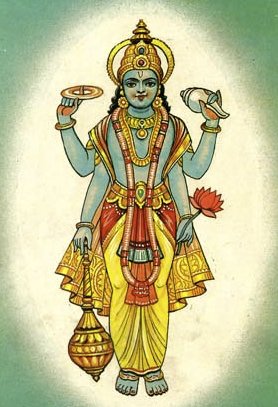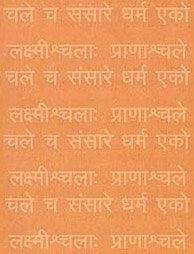Manomaya, Manomayā, Manas-maya, Mano-maya: 14 definitions
Introduction:
Manomaya means something in Buddhism, Pali, Hinduism, Sanskrit, Marathi. If you want to know the exact meaning, history, etymology or English translation of this term then check out the descriptions on this page. Add your comment or reference to a book if you want to contribute to this summary article.
In Hinduism
Vaishnavism (Vaishava dharma)
Source: Pure Bhakti: Bhagavad-gita (4th edition)Manomaya (मनोमय) refers to “third of the five stages of consciousness in which one is conscious of the mind (13.5)”. (cf. Glossary page from Śrīmad-Bhagavad-Gītā).

Vaishnava (वैष्णव, vaiṣṇava) or vaishnavism (vaiṣṇavism) represents a tradition of Hinduism worshipping Vishnu as the supreme Lord. Similar to the Shaktism and Shaivism traditions, Vaishnavism also developed as an individual movement, famous for its exposition of the dashavatara (‘ten avatars of Vishnu’).
Vedanta (school of philosophy)
Source: Shodhganga: Siva Gita A Critical StudyManomaya (मनोमय) or Manomayakośa refers to the “mind-formed sheath” and represents one of the five philosophical kośas (“sheaths”) through which the soul functions simultaneously in the various planes or levels of existence.—Manomaya-kośa is the lower astral body, from manas, “thought, will, wish”. The instinctive-intellectual sheath of ordinary thought, desire and emotion. The manomaya-kośa takes form as the physical body develops and is discarded in the inner worlds before rebirth.

Vedanta (वेदान्त, vedānta) refers to a school of orthodox Hindu philosophy (astika), drawing its subject-matter from the Upanishads. There are a number of sub-schools of Vedanta, however all of them expound on the basic teaching of the ultimate reality (brahman) and liberation (moksha) of the individual soul (atman).
In Buddhism
Theravada (major branch of Buddhism)
Source: Pali Kanon: Pali Proper NamesA Pacceka Buddha. M.iii.70; ApA.i.107.
Theravāda is a major branch of Buddhism having the the Pali canon (tipitaka) as their canonical literature, which includes the vinaya-pitaka (monastic rules), the sutta-pitaka (Buddhist sermons) and the abhidhamma-pitaka (philosophy and psychology).
Mahayana (major branch of Buddhism)
Source: Wisdom Library: Maha Prajnaparamita SastraManomayā or Manomayā-iddhi refers to “creation of a physical body (the double of oneself)” and represents a type of Iddhi (magical process) which is related to the Sanskrit Ṛddyabhijñā: one of the six “superknowledges” (abhijñā), according to the 2nd century Mahāprajñāpāramitāśāstra chapter XLIII.

Mahayana (महायान, mahāyāna) is a major branch of Buddhism focusing on the path of a Bodhisattva (spiritual aspirants/ enlightened beings). Extant literature is vast and primarely composed in the Sanskrit language. There are many sūtras of which some of the earliest are the various Prajñāpāramitā sūtras.
Languages of India and abroad
Pali-English dictionary
Source: BuddhaSasana: Concise Pali-English Dictionarymanomaya : (adj.) mind made.
Source: Sutta: The Pali Text Society's Pali-English DictionaryManomaya refers to: made of mind, consisting of mind, i.e. formed by the magic power of the mind, magically formed, explained at Vism. 405 as “adhiṭṭhāna-manena nimmitattā m. ”; at DA. I, 120 as “jhāna-manena nibbatta”; at DhA. I, 23 as “manato nipphanna”; at VvA. 10 as “bāhirena paccayena vinā manasā va nibbatta.” Dh. 1, 2; J. VI, 265 (manomayaṃ sindhavaṃ abhiruyha); Sdhp. 259; as quality of iddhi: Vism. 379, 406.—Sometimes a body of this matter can be created by great holiness or knowledge; human beings or gods may be endowed with this power D. I, 17 (+pītibhakkha, of the Ābhassaras), 34 (attā dibbo rūpī m. sabbaṅga-paccaṅgī etc.), 77 (id.), 186 (id.); Vin. II, 185 (Koliya-putto kālaṃ kato aññataraṃ mano-mayaṃ kāyaṃ upapanno); M. I, 410 (devā rūpino m.); S. IV, 71; A. I, 24; III, 122, 192; IV, 235; V, 60.
Note: manomaya is a Pali compound consisting of the words mano and maya.

Pali is the language of the Tipiṭaka, which is the sacred canon of Theravāda Buddhism and contains much of the Buddha’s speech. Closeley related to Sanskrit, both languages are used interchangeably between religions.
Marathi-English dictionary
Source: DDSA: The Molesworth Marathi and English Dictionarymanōmaya (मनोमय).—a (S) Relating to the mind or heart; mental, cordial, internal.
Source: DDSA: The Aryabhusan school dictionary, Marathi-Englishmanōmaya (मनोमय).—a Mental, cordial.
Marathi is an Indo-European language having over 70 million native speakers people in (predominantly) Maharashtra India. Marathi, like many other Indo-Aryan languages, evolved from early forms of Prakrit, which itself is a subset of Sanskrit, one of the most ancient languages of the world.
Sanskrit dictionary
Source: DDSA: The practical Sanskrit-English dictionaryManomaya (मनोमय).—a. Mental, spiritual; मनोमयः प्राणशरीरनेता प्रतिष्ठितोऽन्ने हृदयं संनिधाय (manomayaḥ prāṇaśarīranetā pratiṣṭhito'nne hṛdayaṃ saṃnidhāya) Muṇḍ. Up.2.2.7.
--- OR ---
Manomaya (मनोमय).—see separately.
Manomaya is a Sanskrit compound consisting of the terms manas and maya (मय).
Source: Cologne Digital Sanskrit Dictionaries: Cappeller Sanskrit-English DictionaryManomaya (मनोमय).—[feminine] ī spiritual, mental.
Source: Cologne Digital Sanskrit Dictionaries: Monier-Williams Sanskrit-English Dictionary1) Manomaya (मनोमय):—[=manas-maya] [from manas > man] mf(ī)n. spiritual (as opp. to, ‘material’), [Ṛg-veda]
2) [=mano-maya] [from mano > man] mf(ī)n. consisting of spirit or mind, spiritual, mental, [Śatapatha-brāhmaṇa; Upaniṣad] etc.
[Sanskrit to German]
Sanskrit, also spelled संस्कृतम् (saṃskṛtam), is an ancient language of India commonly seen as the grandmother of the Indo-European language family (even English!). Closely allied with Prakrit and Pali, Sanskrit is more exhaustive in both grammar and terms and has the most extensive collection of literature in the world, greatly surpassing its sister-languages Greek and Latin.
Nepali dictionary
Source: unoes: Nepali-English DictionaryManomaya (मनोमय):—adj. 1. spiritual; 2. mental;
Nepali is the primary language of the Nepalese people counting almost 20 million native speakers. The country of Nepal is situated in the Himalaya mountain range to the north of India.
See also (Relevant definitions)
Starts with: Manomaya Iddhi, Manomayakosha.
Ends with: Sumanomaya.
Full-text (+13): Manomayakosha, Kosha, Sumanomaya, Vikarya, Pancakosha, Sannamaya, Pranasharira, Sthavishtha, Purusha, Attapatilabha, Vitarkkam, Iddhi, Abhinimminati, Sukshmasharira, Sadyojata, Vijnanamayakosha, Anandamayakosha, Annamayakosha, Pranamayakosha, Vanmaya.
Relevant text
Search found 60 books and stories containing Manomaya, Manomayā, Manas-maya, Manōmaya, Mano-maya; (plurals include: Manomayas, Manomayās, mayas, Manōmayas). You can also click to the full overview containing English textual excerpts. Below are direct links for the most relevant articles:
Taittiriya Upanishad Bhashya Vartika (by R. Balasubramanian)
Verse 1.113-114 < [Book 1 - Śīkṣāvallī]
Verse 2.288 < [Book 2 - Brahmavallī]
Verse 2.287 < [Book 2 - Brahmavallī]
Sahitya-kaumudi by Baladeva Vidyabhushana (by Gaurapada Dāsa)
Mundaka Upanishad with Shankara’s Commentary (by S. Sitarama Sastri)
Verse 2.2.7 < [Mundaka II, Khanda II]
Concept of Mind in the Major Upanishads (by Gisha K. Narayanan)
8. The Psychological aspects in the Bṛhadāraṇyakopaniṣad < [Chapter 5 - The Psychological aspects as reflected in the Upaniṣads]
11. The Concept of Mind in the Bṛhadāraṇyakopaniṣad < [Chapter 4 - The concept of Mind in the Major Upaniṣads]
8(a). The Concept of Mind in the Taittirīyopaniṣad < [Chapter 4 - The concept of Mind in the Major Upaniṣads]
Shrimad Bhagavad-gita (by Narayana Gosvami)
Taittiriya Upanishad (by A. Mahadeva Sastri)
Chapter XIII - Manomaya-kośa < [A - Brahmavidyā expounded]
Lesson VI - Contemplation of Brahman < [Book I - Shiksha Valli]
Chapter XIV - Vijñānamaya-kośa < [A - Brahmavidyā expounded]